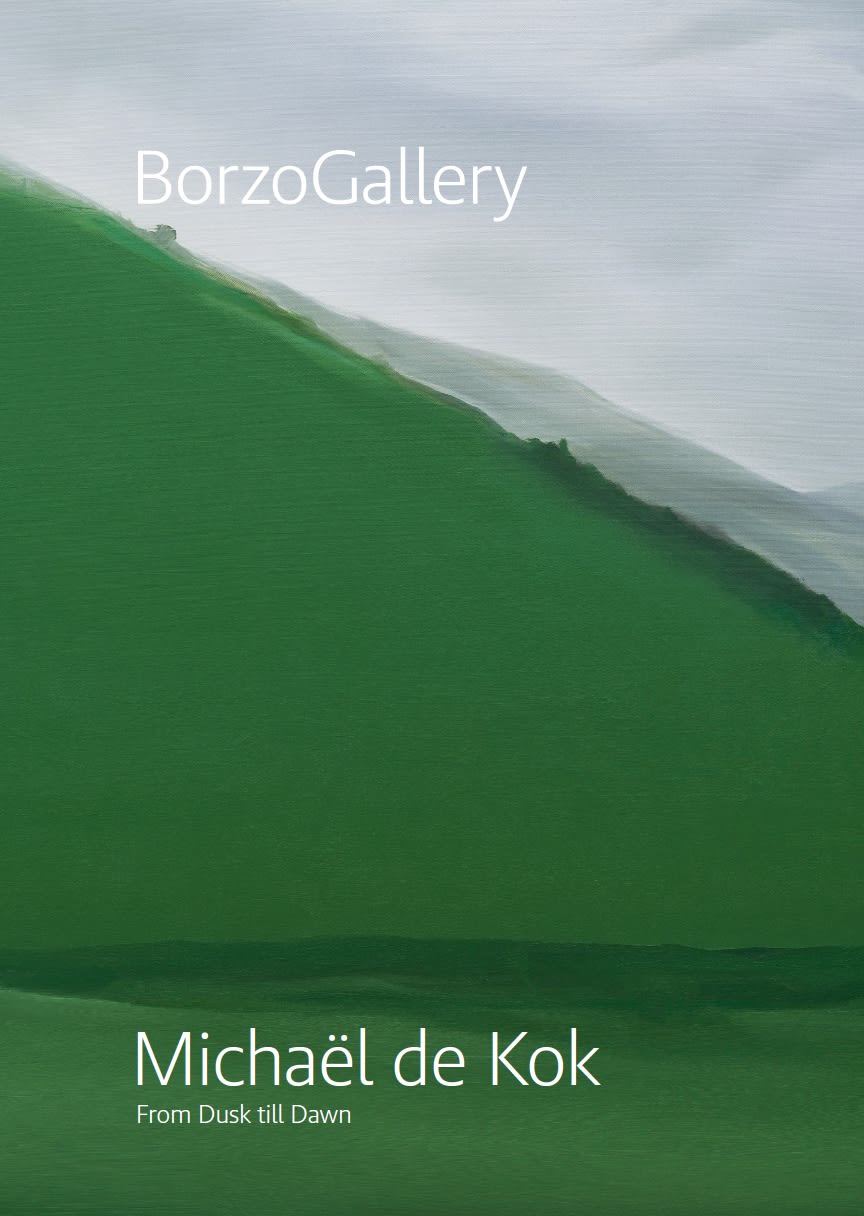Michaël de Kok Dutch, b. 1958
The paintings by Michaël de Kok (*1958) are born out of his fascination with landscapes, but are increasingly becoming an ode to both colour and paint. Even though he studied at the infamous Amsterdam Rijksacademie and currently resides in the Netherlands, De Kok has always felt a strong connection with the Flemish pictorial tradition, as well as with artists such as Raoul De Keyser (1930-2012).
Michaël de Kok’s name has become synonymous with the art of landscape painting. Initially, his landscapes were characterised by open spaces, silence and a lack of shadow. At times, they are intersected by a motorway or a bridge. Once in a while they feature people who – usually on their own – traverse their overwhelming yet inhospitable surroundings: hikers or mountaineers, dressed in anoraks and carrying backpacks.
Slowly but surely a sense of desolation seeped into his work. The painter would occasionally sprinkle his landscapes with mysterious, abandoned, angular structures – obstacles that would catch our attention, symbols of the haphazard way man treats nature. The colours would change as well. At the start of his career, Michaël de Kok adhered to a rather limited colour scheme. Often, he would resort to the Low Countries’ many shades of grey, which he encountered in the fast-moving clouds, mist and fog, or the wet asphalt after a rainstorm. In the meantime, his landscapes have become brighter and more colourful; a testimony to De Kok’s excellent awareness of colour.
Landscape memories
At the same time, Michaël de Kok’s landscapes are quite the opposite of what we have come to know as landscapes. The artist may have always been inspired by existing landscapes – be it by the natural beauty near his studio in Tilburg, or the French and Spanish Pyrenees, which he loved to explore on his long walks –, what concerns him is not a topographically perfect rendition. Actually, his landscapes tend to be memories: he paints them by heart, and so to speak, with his eyes closed. They are anonymous landscapes and mental representations of various views. Michaël de Kok comments: “When I’m painting, there’s always this moment during which the painted image starts to suppress the memory of the image, the reality of the memory gives way to the suggestion of what is painted.” De Kok seemingly paints what is real, whereas he is in fact creating ‘post-images’, and a whole new world of paint.
Landscape painting as a genre has been around for centuries, and its history is long and fascinating. During the 20th century, artists have taken the landscape firmly into their own hands. In that respect, De Kok finds himself excellent company. Similar to De Kok, French-Russian painter Nicolas de Staël was inspired by his observation of the land and sea, although he allowed that impression to completely boil down, and would then develop it further, albeit in quite a rudimentary fashion.
Over the last few years, Michaël de Kok has been increasingly exploring the boundaries of figurative art. Spectators had already been pushed for a while to wonder whether the sky, mountains, buildings and roads in his paintings were actually still referencing reality. Did his work not gradually start to be about just colour, shape and paint?
Ever since 2016, De Kok has been examining to what extent he can reduce a landscape to an abstract concept: clouds, mountains, lakes, meadows, roads and buildings emerge as blocks of colours and patches of paint. Brilliant shades of colours and brush strokes that flow and swirl and thus convey a picture of mountains, valleys and rivers. The landscape is being converted into paint.
For a while now, he has resorted to creating resolutely abstract work: it seems as if he has turned the landscape at 45 degrees, causing the horizon to ‘stand’ vertically. Most often, he paints two patches of colour, a matte one and a more glossy one. The patches appear monochromous, yet contain various subtle hues, traces of brush strokes, and sometimes shadows of figurative elements. Those two patches meet at a borderline put under pressure by the painter, a vertical horizon that at times frazzles out, and appears darker: a line painted thicker and more vigorously that also contains other colours. From time to time, Michaël de Kok paints those two blocks of colours on two separate canvasses, which he hangs side-by-side, allowing the least possible amount of space in between.
A path of his own
Michaël de Kok’s paintings might have been born out of a fascination with the landscape; they have increasingly become an ode to both colour and paint. Michaël de Kok is carving out a path of his own, which runs somewhere in between Mark Rothko’s en Barnett Newman’s.
This text is an edited version of an article by Eric Rinckhout that previously appeared in (H) art Magazine (nr. 167, February 23, 2017)
-

Art Rotterdam 2022
Stand 11 19 - 22 May 2022JAN COMMANDEUR | MICHAËL DE KOK | KOEN VERMEULE | RONALD ZUURMOND STAND 11 On our stand at Art Rotterdam 2022 the main focus is on new work by four...Read more -

Michaël de Kok | Inaugural exhibition
22 Nov 2019 - 18 Jan 2020Michaël de Kok paints memories of landscapes that he traverses with his dog during walks. The figurative elements that can be found in his earlier works, however, have made way...Read more










